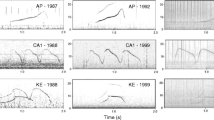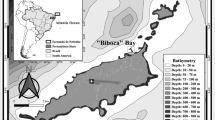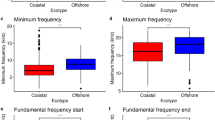Summary
The whistle vocalizations of two bottlenosed dolphins, Tursiops truncatus, were recorded at the Sealand Aquarium in Brewster, Massachusetts. The identification of which dolphin within the group produced a vocalization was made possible by a telemetry device attached to the dolphin's head with a suction cup. 77% of the identified whistles (219 our of 284) fell into two primary categories, type 1 and type 2 (Table 1). The remaining 23% of whistles fell into five secondary categories. Of the primary whistles produced by one dolphin, 78% were of type 1 (22% type 2), while 69% of primary whistles from the other dolphin were of type 2 (31% type 1). The result that each of the dolphins favored a different primary whistle supports the findings of Caldwell and Caldwell (1965), that each dolphin produces an individually distinctive whistle. But in the present study, both dolphins produced both primary whistle types. This may represent mimicry of signature whistles.
Similar content being viewed by others
References
Burdin VI, Reznik AM, Shornyakov VM, Chupakov AG (1975) Communication signals of the Black Sea bottlenose dolphin. Sov Phys Acoust 20:314–318
Caldwell MC, Caldwell DK (1965) Individualized whistle contours in bottlenosed dolphins (Tursiops truncatus). Nature 207:434–435
Caldwell MC, Caldwell DK (1968) Vocalization of naive captive dolphins in small groups. Science 159:1121–1123
Caldwell MC, Caldwell DK (1971) Statistical evidence for individual signature whistles in Pacific whitesided dolphins, Lagenorhynchus obliquidens. Cetology 3:1–9
Caldwell MC, Caldwell DK (1973) Vocal mimicry in the whistle mode by an Atlantic bottlenosed dolphin. Cetology 9:1–8
Caldwell MC, Caldwell DK (1979) The whistle of the Atlantic bottlenosed dolphin (Tursions-truncatus)-ontogeny. In: Winn HE, Olla BI (eds) Behavior of marine animals, vol. 3: Cetaceans. Plenum, New York, vol 3, pp 369–401
Caldwell MC, Caldwell DK, Turner RH (1970) Statistical analysis of the signature whistle of an Atlantic bottlenosed dolphin with correlations between vocal changes and level of arousal. In: Technical Report Number 8, Los Angeles County Museum of Natural History Foundation
Caldwell MC, Caldwell DK, Miller JF (1973) Statistical evidence for individual signature whistles in the spotted dolphin, Stenella plagiodon. Cetology 16:1–21
Dreher JJ (1961) Linguistic considerations of porpoise sounds. J Acoust Soc Am 33:1799–1800
Dreher JJ (1966) Cetacean communication: small group experiment. In: Norris KS (ed) Whales, dolphins, and porpoises. University of California Press, Berkeley, pp 529–543
Dreher JJ, Evans WE (1964) Cetacean communication. In: Tavolga WN (ed) Marine bioacoustics, vol 1 Pergamon, Oxford, pp 373–393
Evans WE (1967) Vocalization among marine mammals. In: Tavolga WN (ed) Marine bioacoustics, vol 2. Pergamon, Oxford, pp 159–186
Gish SL (1979) A quantitative description of two-way acoustic communication between captive Atlantic bottlenosed dolphins (Tursiops truncatus Montagu). PhD Thesis, University of California at Santa Cruz, University Microfilms, Ann Arbor
Graycar PJ (1976) Whistle dialects of the Atlantic bottlenosed dolphin, Tursiops truncatus. PhD Thesis, University of Florida, University Microfilms, Ann Arbor
Herman LM (1980) Cognitive characteristics of dolphins. In: Herman LM (ed) Cetacean behavior: mechanisms and functions. Wiley, New York, pp 363–429
Herman LM, Tavolga WN (1980) The communication systems of cetaceans. In: Herman LM (ed) Cetacean behavior: mechanisms and functions. Wiley, New York, pp 149–210
Lilly JC (1963) Distress call of the bottlenose dolphin: stimuli and evoked behavioral responses. Science 139:116–118
Lilly JC (1965) Vocal mimicry in Trusiops: Ability to match numbers and durations of human vocal bursts. Science 147:300–301
Penner RH (1966) Conditioned whistle replication in Tursiops truncatus (Montagu). In: Technical Report, 17 April 1966, Listening Inc for US Naval Ordnance Test Station, China Lake CA
Popper AN (1980) Sound emission and detection by delphinids. In: Herman LM (ed) Cetacean behavior: Mechanisms and functions. Wiley, New York, pp 1–52
Richards DG, Wolz JP, Herman LM (1984) Vocal mimicry of computer-generated sounds and vocal labelling of objects by a bottlenosed dolphin, Tursiops truncatus. J Comp Psychol 98:10–28
Siegel S (1956) Nonparametric statistics for the behavioral sciences. McGraw-Hill, New York
Tyack P (1985) An optical telemetry device to identify which dolphin produces a sound J Acoust Soc Am (in press)
Watkins WA, Wartzok D (1985) Sensory biophysics of marine mammals. Marine Mammal Science (in press)
Author information
Authors and Affiliations
Rights and permissions
About this article
Cite this article
Tyack, P. Whistle repertoires of two bottlenosed dolphins, Tursiops truncatus: mimicry of signature whistles?. Behav Ecol Sociobiol 18, 251–257 (1986). https://doi.org/10.1007/BF00300001
Received:
Accepted:
Issue Date:
DOI: https://doi.org/10.1007/BF00300001




